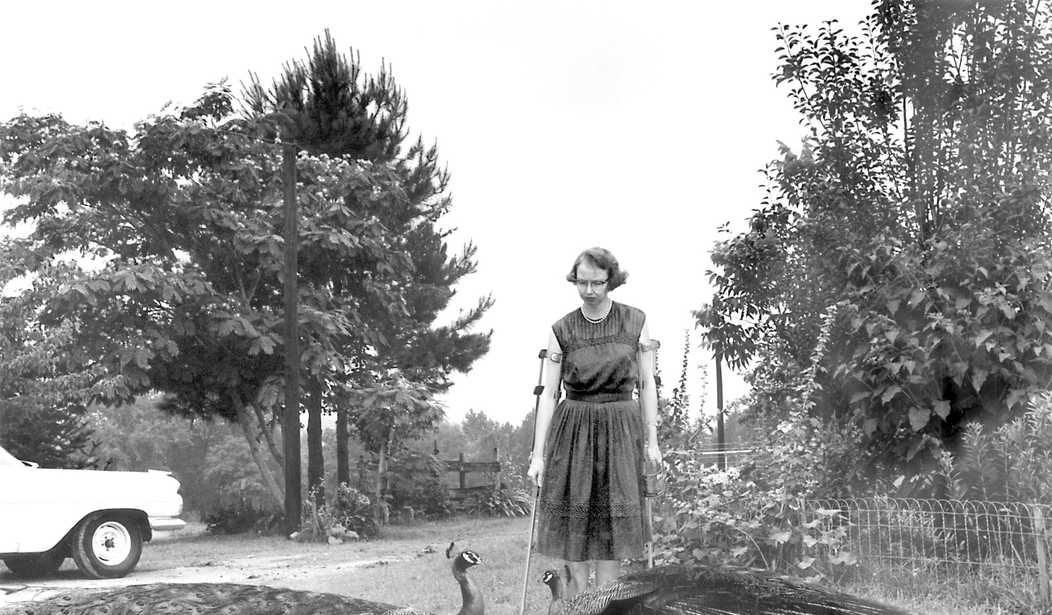Shortly after Easter, 1958, an elderly cousin of Flannery O’Connor offered the writer and her mother an all-expense paid visit to Lourdes. Paul Elie, author of The Life You Save May Be Your Own: An American Pilgrimage, wrote that O’Connor went to the Lourdes waters in “a dress, a long sweater and brandished a pair of aluminum crutches,” a look that O’Connor said made her look like “a structure with flying buttresses.” O’Connor imagined that the trip to Lourdes would be a “comic nightmare” with “a planeload of fortress-footed female Catholics being pushed from shrine to shrine,” and yet what she found and noted in her letters was the “distinct body odor of the crowd.”
Leave it to O’Connor to tell the truth while mixing the sacred with acerbic witticisms. After managing to fill a thermos of water for a friend back home who was thinking of becoming a lay member of the Carmelite Order, she admitted, “I am one of those people who could die for his religion easier than taking a bath for it.”
From Lourdes, O’Connor and her mother went to Rome where the writer had an audience with Pope Pius XII, then eighty years old. Elie describes O’Connor’s time in Rome as a period when she revealed her true “church lady” self. But the author of two novels, three short story collections and six other books was no ordinary “church lady,” as Daniel Moran illustrates in his remarkable study of O’Connor, Creating Flannery O’Connor, a detailed look at the writer and her critics, publishers and readers.
Published by the University of Georgia Press, this book belies traditional notions of dry, academic scholarship. Moran, who teaches writing at Rutgers University and history at Monmouth University, examines every aspect of O’Connor’s reputation as he fuses hard scholarship with pop culture references to O’Connor’s work.
O’Connor, who could easily be called the most misunderstood Catholic writer of the 20th century — a Catholic bishop in 2000 banned O’Connor’s A Good Man Is Hard to Find from Catholic schools in Lafayette, Louisiana — began her career at 21 when she applied for admission to the Iowa Writers’ Workshop. Her southern dialect was so thick then that she could only make herself understood by writing her name and her request to be admitted on a piece of paper.
Part of the O’Connor myth is that her illness was responsible for her art. O’Connor suffered from lupus erythematosus and died of the disease in 1964. “That she died of a slowly working disease about which relatively little was known allowed critics to link her illness with her art … that O’Connor found repulsive,” Moran writes. O’Connor made it clear that she didn’t want further attention drawn to herself in this way: “My lupus has no business in literary considerations,” she wrote.
Her work was not everybody’s cup of tea. T.S. Eliot once remarked: “She has certainly an uncanny talent of a high order but my nerves are just not strong enough to take much of a disturbance.”
Paul Engle was the director of the Iowa Writers’ Workshop when the young O’Connor walked into his office asking to be admitted to the program. Engle writes:
She came out of the red dirt country of Georgia. She walked into my office one day and spoke to me. I understood nothing, not one syllable. As far as I knew, she was saying, “Aaaaraaaraaarah.” My God, I thought to myself, this is a retarded young girl. Then I looked at her eyes. They were crossed! Finally, I said, excuse me, my name is Paul Engle. I gave her a pad — believe me, this is true — and said would you please write down what you’re telling me. And she wrote, “My name is Flannery O’Connor. I’m from Milledgeville, Georgia. I’m a writer.”
O’Connor, after all, grew up on a farm, and once taught a chicken how to walk backwards.
After her first novel Wise Blood was published in 1952, it was selected by John Huston for film adaptation. Huston, an avid atheist, assumed the story was a kind of morality tale on what happens when people take religion too seriously. This was the story of Hazel Motes who grew up in a Christian fundamentalist family and who later declared “war” on God by inventing his own Church, “The Church Without Christ.” When Motes later repents of his actions, he blinds himself as an act of penance, another “do it yourself” action because, as O’Connor suggests, he has no access to the sacraments of the Catholic Church. O’Connor wrote: “Haze is saved by virtue of having wise blood; it’s too wise for him to ultimately deny Christ. Wise blood has to be these people’s means of grace — they have no sacraments.”
“The religion of the South is a do-it-yourself religion, something which I as a Catholic find painful and touching and grimly comic,” O’Connor said. She added that these religions are “full of unconscious pride that leads to all sorts of ridiculous religious predicaments.”
Wise Blood confused Huston because he failed to get the story’s subtext: that the real culprit of religious fanaticism was the southern, Protestant “do-it-yourself” religion, where “churches” and preachers with fiery zeal invent doctrines and dogmas as they go along. Huston simply thought of it as a satire about how ridiculous Christianity was.
Brad Dourif, who played Hazel Motes in Huston’s film, once had a conversation with the director about the meaning of the story: “I remember we were in rehearsal and I finally asked the question. I said, ‘Well, what do you think happens? Because it seems to me that the script is very clearly saying that Hazel Motes finds God and that’s what happened, and he dedicates his life to it.’ And he [Huston] said, ‘No, no, no, no, no.’”
Like many modern Hollywood secular progressives, Huston believed that it was “foolishly impudent to speculate on the existence of any kind of God.” “The only religion I believe in is creativity,” he wrote. “I’m interested in the Bible as a universal myth, as a prop for numerous legends.”
Huston also added: “Every day I’m being asked if I am a believer and I answer I have nothing in common with Cecil B. DeMille.”
The film was shot on a limited budget and later premiered at Cannes and the New York Film Festival, garnishing excellent reviews — but major distributors stayed away. The Village Voice wrote that Wise Blood was “precisely the kind of property that would have made the late Louis B. Mayer turn over in his grave.” When New Line Cinema picked it up, Hollywood’s power brokers gave it a thumbs down. Sassy critics who classified themselves as intellectuals assumed the film was an expose of religious cults. Other critics like Vincent Canby called it “one of John Huston’s most original, most stunning movies.” Rex Reed said the film “looks like it was made by people with no idea of what commercial gimmicks are.”
New York magazine said that the film was about “the familiar, Jesus-haunted South, where a ranting prophet, saint or con man stands on every corner.” Moran suggests that many critics saw what they wanted to see in the film, “as if the screen were a means of reflecting back their assumptions about the South and those who lived there.”
As for O’Connor, she remarked: “Anything that comes out of the South is going to be called grotesque by the northern reader, unless it is grotesque, in which case it is going to be called realistic.”
As for Huston, when he had completed Wise Blood, he experienced a revelation of sorts and realized that he had been had. He said, “I’ve told another story than the one I thought I was telling. I’ve told Flannery O’Connor’s story.”
Dourif recalls a meeting Huston had with the film’s producers and actors. “We’re all sitting around the table and Huston kind of looks up at everybody and he looks around and says, ‘Jesus wins.’”









Join the conversation as a VIP Member